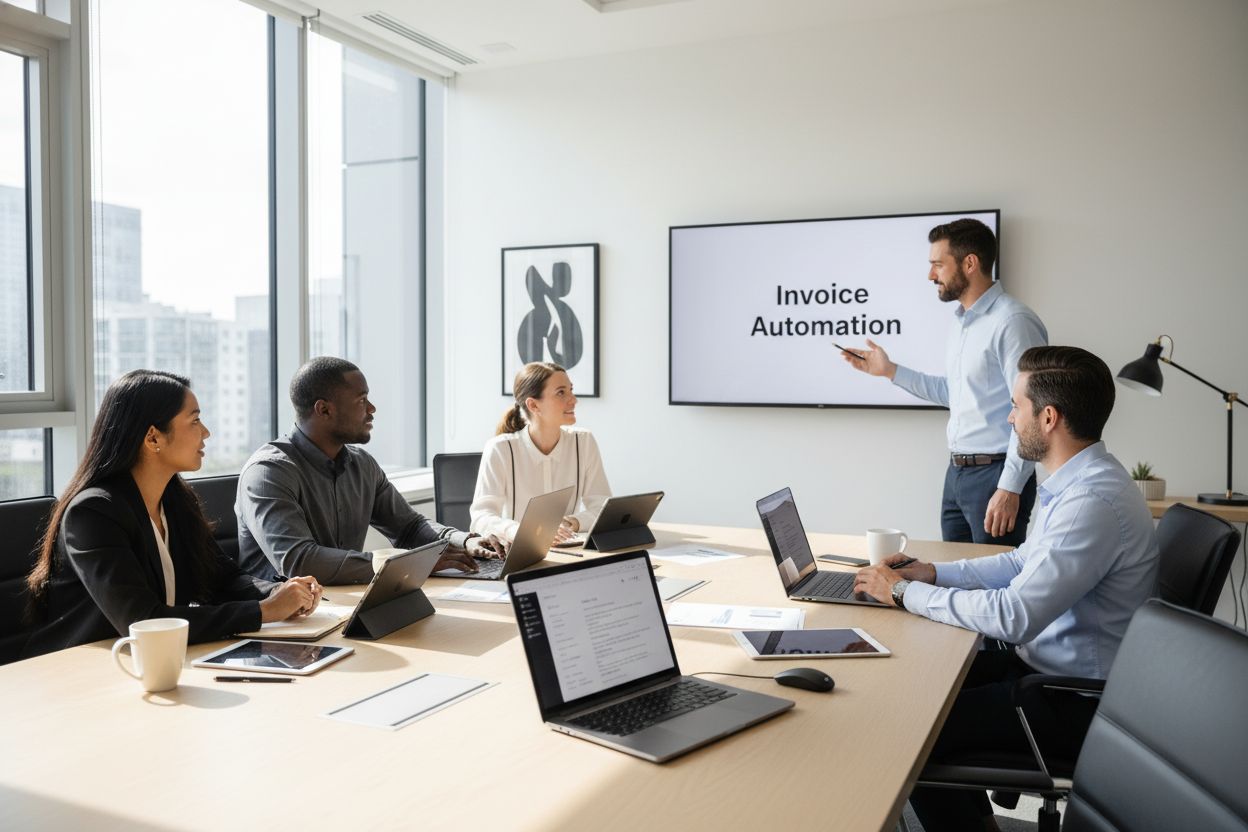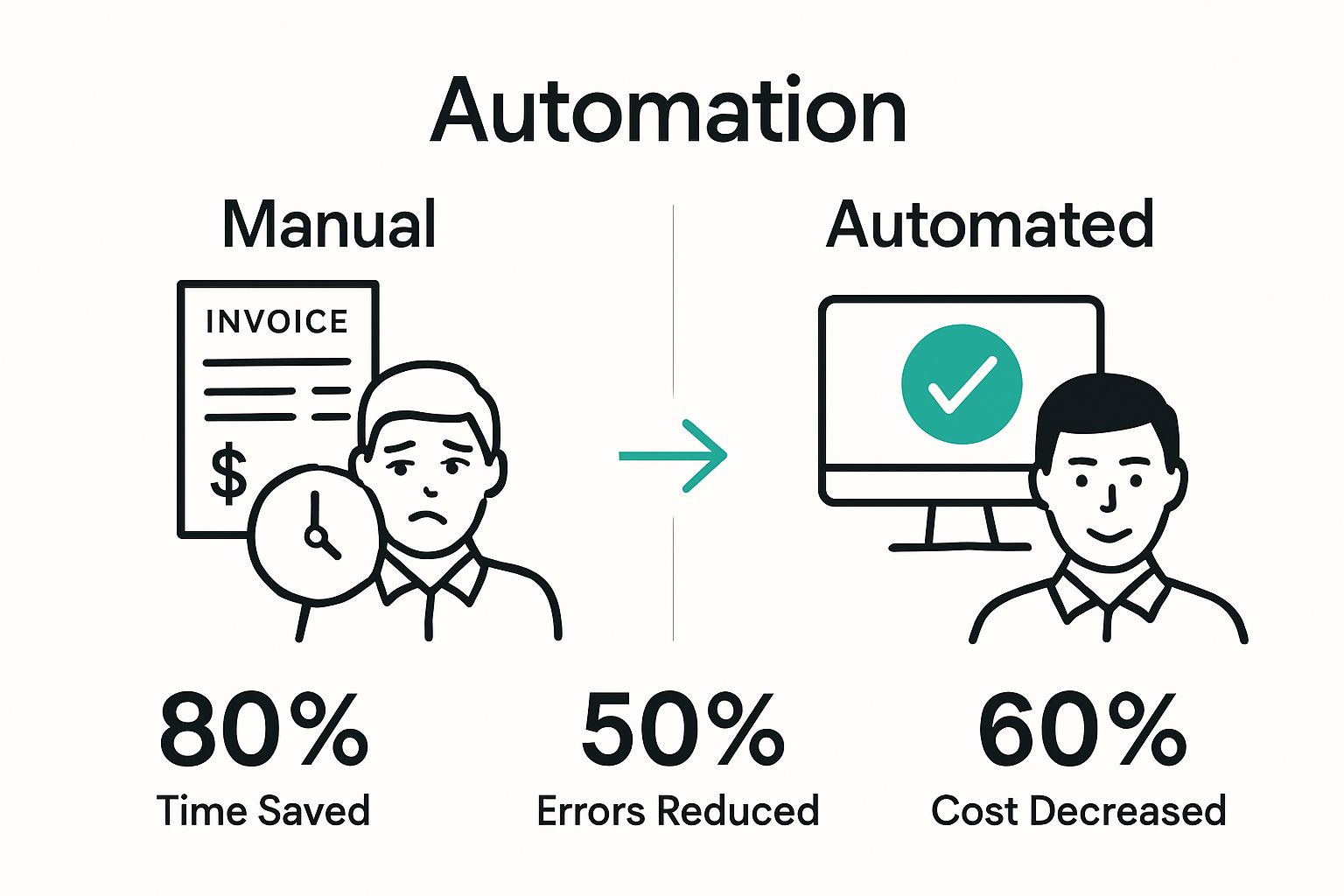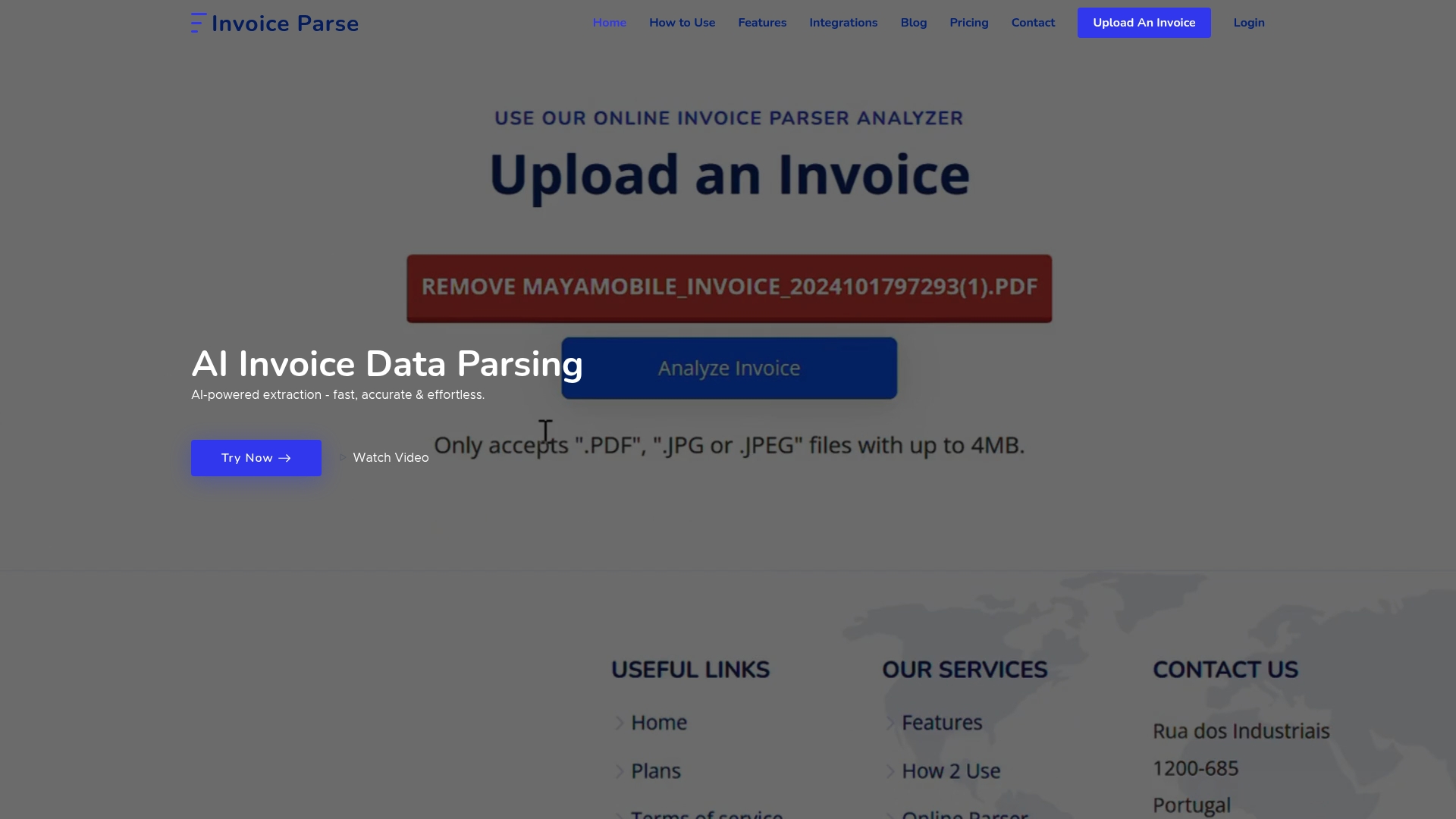Invoice automation is changing how businesses handle their financial documents. The old days of endless paperwork and tireless manual entry are quickly fading away. But get this. Companies using advanced invoice automation can reduce processing costs by up to 80 percent, which sounds amazing on its own. The surprising part is that the most valuable shift is not just about saving money, it is about accuracy and freeing up teams to focus on ideas that drive real growth.

Understanding What is Invoice Automation for Businesses
Table of Contents
- Defining Invoice Automation: Key Features And Components
- The Importance Of Invoice Automation In Modern Business
- How Invoice Automation Works: The Underlying Technology
- Key Benefits Of Implementing Invoice Automation
- Real-World Applications: Case Studies And Examples
Quick Summary
| Takeaway | Explanation |
|---|---|
| Invoice automation reduces processing costs by up to 80%. | Implementing automated invoice processing significantly lowers operational expenses associated with manual labor and errors. |
| Enhances accuracy by eliminating human errors. | Automated systems minimize mistakes inherent in manual data entry, leading to more reliable financial data management. |
| Accelerates invoice processing time dramatically. | The time taken to process invoices can be reduced from days to minutes, improving overall operational efficiency. |
| Provides real-time financial insights. | Automation enables instant access to precise financial information, aiding in better decision-making. |
| Transforms financial operations into intelligent workflows. | By automating tasks, businesses can focus on strategic activities rather than repetitive administrative processes. |
Defining Invoice Automation: Key Features and Components
Invoice automation represents a sophisticated technological approach that transforms traditional invoice processing by leveraging advanced digital tools and artificial intelligence. At its core, this strategy replaces manual data entry and paper-based workflows with intelligent, digital systems that extract, validate, and process invoice information seamlessly.
Core Technological Components
The architecture of invoice automation is built upon several critical technological foundations:
- Optical Character Recognition (OCR): Converts printed or handwritten invoice documents into machine-readable text
- Machine Learning Algorithms: Enables systems to learn from historical invoice patterns and improve data extraction accuracy
- Natural Language Processing: Helps interpret complex invoice language and context
Data Extraction and Validation Mechanisms
Modern invoice automation goes beyond simple data capture. Our comprehensive guide on invoice processing strategies reveals that these systems perform multiple sophisticated tasks. They can automatically:
- Identify and extract key invoice fields like vendor names, amounts, dates, and tax information
- Cross-reference invoice data with existing purchase orders and contracts
- Flag potential discrepancies or anomalies for human review
According to McKinsey Digital Research, companies implementing advanced invoice automation can reduce processing costs by up to 80% and minimize human error rates significantly. The technology transforms financial workflows from labor-intensive manual processes to streamlined, intelligent systems that deliver unprecedented accuracy and efficiency.
The Importance of Invoice Automation in Modern Business
Invoice automation has emerged as a critical strategy for businesses seeking operational excellence and financial efficiency. By transforming traditional manual processes into intelligent digital workflows, organizations can unlock substantial strategic advantages across multiple operational domains.
Financial Performance and Cost Reduction
The economic implications of invoice automation are profound. Our comprehensive guide on business automation strategies highlights that implementing automated invoice processing can dramatically reduce operational expenses. Businesses typically experience significant cost savings through:
- Reducing manual labor hours dedicated to invoice processing
- Minimizing errors associated with manual data entry
- Accelerating payment cycles and improving vendor relationships
Strategic Operational Benefits
Beyond pure financial metrics, invoice automation delivers multifaceted operational improvements. According to Deloitte’s Digital Transformation Research, organizations leveraging advanced automation technologies can achieve:
- Enhanced Accuracy: Eliminating human error in financial data management
- Real-time Financial Insights: Instant access to precise financial information
- Improved Compliance: Standardized processing that meets regulatory requirements
The strategic value extends far beyond immediate cost savings. By freeing financial teams from repetitive administrative tasks, businesses can redirect human capital toward more complex, value-generating activities such as financial analysis, strategic planning, and business development.
Automated invoice processing is no longer a luxury but a fundamental requirement for competitive, forward-thinking organizations.
How Invoice Automation Works: The Underlying Technology
Invoice automation represents a complex technological ecosystem that integrates multiple advanced digital technologies to transform financial document processing. Our workflow automation guide reveals the intricate mechanisms that enable seamless, intelligent invoice management.
Data Capture and Extraction Technologies
The initial stage of invoice automation involves sophisticated data capture technologies that convert physical or digital documents into structured, machine-readable information. These technologies leverage:
- Optical Character Recognition (OCR) for converting printed text
- Advanced image processing algorithms for handling diverse document formats
- Machine learning models trained on thousands of invoice templates
Intelligent Processing and Validation
Once data is extracted, intelligent processing systems perform complex validation and interpretation tasks. According to Gartner’s Digital Transformation Research, these systems utilize:
- Natural Language Processing (NLP): Understanding contextual nuances in invoice text
- Machine Learning Algorithms: Identifying patterns and potential anomalies
- Rule-based Validation: Cross-referencing extracted data with predefined business rules
The final stage involves automated routing, approval workflows, and seamless integration with existing enterprise resource planning (ERP) systems. By combining these technological components, invoice automation creates an intelligent, self-learning ecosystem that continuously improves accuracy and efficiency.
To help clarify the core technologies involved in invoice automation, the table below summarizes each component and its role in transforming financial document processing.
| Technological Component | Function |
|---|---|
| Optical Character Recognition (OCR) | Converts printed or handwritten invoices into machine-readable text |
| Machine Learning Algorithms | Improves data extraction accuracy by learning from historical invoice data |
| Natural Language Processing | Interprets complex invoice language and contextual details |
| Advanced Image Processing | Handles diverse invoice document formats for better capture |
| Rule-based Validation | Cross-references extracted data with business rules |
| Automated Workflow Integration | Routes invoices and integrates with ERP or approval systems |
Key Benefits of Implementing Invoice Automation
Invoice automation delivers transformative advantages that extend far beyond simple administrative efficiency. Our comprehensive guide on invoice automation benefits reveals the profound strategic impact these technologies can have on organizational performance.
Financial Performance and Cost Management
The financial implications of invoice automation are substantial. Businesses can experience significant economic advantages through:
- Reducing processing costs by up to 80%
- Eliminating manual data entry expenses
- Minimizing late payment penalties and potential financial errors
Operational Efficiency and Productivity
According to PwC’s Digital Transformation Research, organizations implementing invoice automation can unlock unprecedented operational capabilities:
- Accelerated Processing Speeds: Reducing invoice processing time from days to minutes
- Enhanced Accuracy: Decreasing human error rates by over 50%
- Improved Vendor Relationships: Enabling faster, more reliable payment cycles
Beyond immediate financial gains, invoice automation represents a strategic investment in organizational agility. By transforming complex, time-consuming manual processes into intelligent, automated workflows, businesses can redirect human capital toward more strategic, value-generating activities.
The table below presents a side-by-side overview of the key operational and financial benefits that businesses experience when implementing invoice automation, highlighting quantifiable outcomes and strategic advantages.
| Benefit Type | Description | Example Impact |
|---|---|---|
| Cost Reduction | Lowers expenses by automating manual processes and reducing errors | Processing costs reduced by up to 80% |
| Accuracy Improvement | Minimizes human error in financial data management | Error rates decreased by over 50% |
| Processing Speed | Accelerates invoice handling from days to minutes | Invoices approved 60% faster at large enterprises |
| Vendor Relationship | Enables prompt and reliable payments | Improved compliance and vendor satisfaction |
| Operational Productivity | Frees up staff for higher value tasks | Immediate productivity gains in small businesses |
| Financial Insights | Provides real-time, precise information | Instant access to financial status and analytics |

Real-World Applications: Case Studies and Examples
Invoice automation transcends theoretical concepts, delivering tangible benefits across diverse industries and organizational scales. Our invoice automation implementation guide showcases how different sectors leverage this transformative technology to drive operational excellence.
Enterprise Level Transformations
Large corporations have pioneered advanced invoice automation strategies, demonstrating significant operational improvements. The Bill & Melinda Gates Foundation exemplifies successful implementation by achieving:
- 60% reduction in invoice approval time
- Enhanced staff satisfaction
- Improved compliance and financial tracking
- Streamlined global grant management processes
Small and Medium Business Adaptations
Small and medium enterprises have equally compelling automation success stories. These organizations typically experience:
- Rapid Implementation: Quick integration with existing financial systems
- Cost-Effective Solutions: Scalable technologies with minimal upfront investment
- Immediate Productivity Gains: Reducing manual processing hours
By embracing invoice automation, businesses across different sectors transform complex financial workflows into efficient, intelligent systems that drive strategic growth and operational resilience.
 The technology represents more than a tool it is a fundamental reimagining of financial management.
The technology represents more than a tool it is a fundamental reimagining of financial management.
Ready to Eliminate Manual Invoice Headaches?
Imagine turning hours of tedious, error-prone invoice entry into a fast, seamless process. The article explained how invoice automation transforms your operations by removing manual work and unlocking new levels of financial accuracy. Are you struggling with slow invoice approvals, high processing costs, or missed vendor deadlines? With Invoice Parse, those pain points become a thing of the past.

Stop wasting resources on repetitive tasks. Experience the power of instant invoice data extraction using our AI-driven platform. Simply upload your invoice—no templates, no complex setup. Structured data such as vendor names, amounts, and line items will be ready in real time. Ready to see the impact for yourself? Learn more about our automation benefits and sign up now to transform your workflow today. The future of invoice processing starts here.
Frequently Asked Questions
What is invoice automation and how does it work?
Invoice automation is a technology-driven process that replaces manual data entry and paper workflows with digital systems that extract and manage invoice information. To understand how it works, consider implementing Optical Character Recognition (OCR) to convert paper invoices into machine-readable formats, which streamlines your entire invoicing process.
What are the key benefits of implementing invoice automation for my business?
Implementing invoice automation can significantly reduce processing costs by up to 80% and minimize errors associated with manual entry. Focus on adopting this technology to improve your financial efficiency and enable quicker payments to vendors, enhancing your business relationships.
How can invoice automation improve my company’s operational efficiency?
Invoice automation enhances operational efficiency by accelerating processing speeds, making it possible to reduce invoice handling time from days to minutes. Start by integrating automated solutions into your current workflow to free up valuable employee time for more strategic tasks.
What components should I consider when choosing an invoice automation system?
When selecting an invoice automation system, focus on technologies like Optical Character Recognition (OCR), machine learning, and natural language processing. Evaluate how these components can enhance data extraction accuracy and streamline your invoice management process.
How do I measure the success of invoice automation implementation?
To measure the success of invoice automation, track key performance indicators like processing costs, error rates, and processing time before and after implementation. Aim for continuous improvement, adjusting strategies as needed to achieve your cost reduction and efficiency goals.
Is invoice automation suitable for small businesses?
Yes, invoice automation is very suitable for small businesses as it provides scalable solutions that can be integrated quickly and cost-effectively. Explore options that allow for immediate productivity gains, enabling your team to handle financial processes more efficiently.
Recommended
- AI Invoice Parse – Understanding Automation for Small Businesses
- AI Invoice Parse – Business Automation Guide: Strategies and Benefits for 2025
- AI Invoice Parse – Automation Guide: Everything You Need to Know in 2025
- AI Invoice Parse – Key Benefits of Invoice Automation for Businesses
- Understanding Customs Invoice Requirements for Trade - Worldwide Express, Inc.
